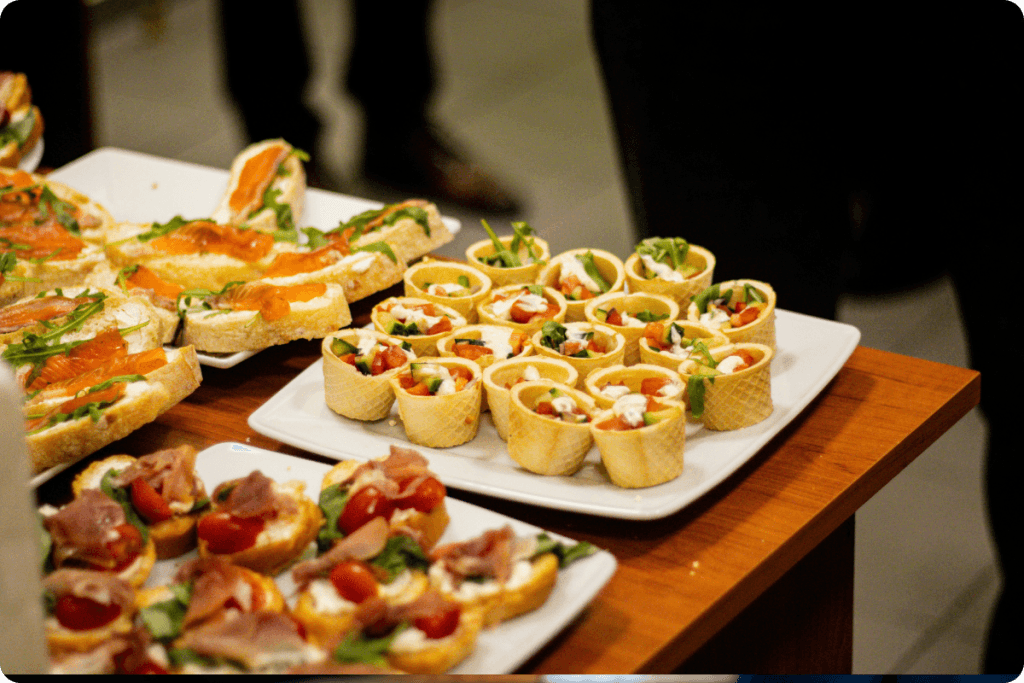Here’s something you might not realise: companies typically allocate between $100 and $500 per employee every year just for team-building activities. That means there’s real money being spent on team lunches, client dinners, and celebratory outings—and your restaurant could be part of that spend.
Corporate and group bookings are more than just a one-time boost to your revenue. These groups usually spend more, stick around longer, and if they have a great time? They come back. We’ve seen restaurants turn one team lunch into a standing monthly booking.
Plus, corporate events are often scheduled during slower hours—like early weekdays or lunchtime—which helps fill those off-peak times. So, if you haven’t tapped into this segment yet, now’s the time. It’s a great way to boost your business without needing to completely revamp your space or menu!
10 ways to grow your corporate and group bookings
If you’ve worked in hospitality long enough, you know that corporate bookings and group reservations are some of the best ways to drive steady, high-value business. When you get them right, it can do wonders in building relationships that keep your calendar full for months.
We’ve picked up a few solid tips over the years, straight from restaurant owners and industry partners, on how to make those larger bookings happen. So, if you’re looking to boost corporate and group reservations at your restaurant, here’s how you can do it without having to completely change up your strategy or space.
1. Offer catering as a gateway to bigger bookings
Catering orders are a great way to get your foot in the door with local businesses. Think about it—companies are always looking for food for team lunches, office celebrations, or meetings that don’t need a full restaurant experience.
We’ve seen restaurant owners start small, just delivering things like sandwich platters and salads to nearby offices for meetings. And sure enough, those same offices came back when they needed a place for an offsite dinner or a retirement party.
The key is to keep it simple: online forms, flexible menus, and reliable delivery. And don’t forget to include a flyer or card with each order to promote your private dining or event services—it’s a low-effort way to keep your space top of mind.

2. Optimise your space for groups
Not every restaurant has a private dining room—and honestly, that’s totally fine. What diners really care about is whether the space feels good for a group. If it’s comfortable, semi-private, and not too loud, you’re halfway there.
Speaking from experience, the Now Book It crew has had team dinners at places that got creative with their setup. One venue used plants and bookshelves to section off part of the dining room, dimmed the lights a touch, and suddenly it felt like our own little area—even though the restaurant was still open. It doesn’t have to be fancy if you’re intentional with giving guests the best possible experience.
If customers can check out a few photos or a quick video of what a group setup looks like before they book? Even better. It just helps with picturing the vibe and making the higher-stakes decisions.
3. Make booking (and rebooking) easy
To land more corporate and group bookings, the reservation process has to be seamless and simple. Plenty of venues miss out simply because their booking system was clunky —leading to instant drop offs— or if it’s a manual booking, taking too long to respond. By the time a staff can get back to the potential client, another venue has already locked it in.
What really makes a difference is having a clear, simple inquiry form on your website and following up quickly with the key details—menu options, pricing, availability. There’s no need for a full proposal in the first reply, just enough to feel like you’ve got it under control.
Over 63% of respondents say they use an online booking platform, with Now Book It being the most popular. That tells you streamlined, digital bookings isn’t just a nice-to-have anymore, it’s a necessity.
And once someone books with you, don’t let it end there. Rebooking or repeat visits are just as important. A small thank-you—like a discount or a complimentary round on their next visit—go a long way in turning a one-time event into a regular thing.
4. Market your venue to the right people
If you want more bookings, you’ve got to get in front of the people who actually make those decisions. Office managers, HR professionals, executive assistants, hotel concierges, and event planners are your MVPs here. Build relationships with local businesses, reach out to nearby hotels, and connect with event pros who are always hunting for reliable venues.
Restaurants can get a solid boost by listing their space on platforms like EventUp or The Vendry, especially for private dining and event bookings. And don’t underestimate LinkedIn or targeted email campaigns—they’re great for reaching professionals looking to plan team dinners, client events, or company celebrations.
And when it comes to winning those corporate and group bookings, timing is everything. We get it—service gets hectic, and it’s easy to miss a call or let an email slip through. That’s why we offer tools like Now Book It’s AI restaurant reservation system. It keeps someone on the line, answers menu enquiries, and makes sure you’re always on top of the booking game—even during a Friday night rush.
5. Use full bookouts to your advantage
Don’t have a private dining room? No problem. We’ve worked with plenty of places that get creative by offering full book outs on slower nights. Closing to regular diners once in a while can be a smart play—just make sure your pricing and minimum guest count make it worth your while.
This works especially well for events that need a bit of exclusivity—think team celebrations, product launches, or high-end client dinners. The vibe of a full restaurant to yourself? That’s a strong selling point for a lot of corporate groups.

6. Create group-friendly menus
Here’s a hot take: your kitchen might not love group events, especially if the menu is kept open ended. The stress hits the back of house when all 25 guests order different mains and expect service at the same time. Events run smoother when you plan a solid and manageable menu.
The restaurants that handle this best usually offer a few tiered packages, priced per head, with just enough variety for it to feel thoughtful without overcomplicating service. It also helps clients stay within budget.
We always recommend including a few dietary-friendly options (vegetarian, gluten-free, etc.) by default. That way, clients don’t have to ask, and your team doesn’t need to scramble to brainstorm new dishes last minute. Offering preorders is another underrated win—it makes timing easier for the kitchen and makes you look like a pro when service runs seamlessly.
7. Don’t forget off-peak opportunities
Not every corporate event needs to happen during peak dinner hours. In fact, who doesn’t love a solid Monday lunch or a Wednesday happy hour? It’s easier to get space, the vibe’s more relaxed, and customers usually get more attention from the staff.
Value packages on off peak periods are also great, for example, a set menu for weekday lunches or complimentary appetisers for early week bookings. Not only does it help customers stretch their dining budget a little further, but it also shows that the restaurant understands their needs.
Objectively speaking, this is a win for both sides: your slower hours get a boost, and group parties get great service without the crowds. It just makes sense.
8. Give your team breathing room
One of the easiest ways to set your team up for success? Build in a proper buffer between the time a guest books and the actual event date. Too many places rely on last minute prep for large bookings—and it rarely goes smoothly.
By setting clear cutoff times for group reservations, you give your team space to plan staffing, prep ingredients, and make sure everything runs like clockwork. It’s a small shift that can seriously improve the guest experience (and reduce the stress on your back-of-house team).
Now Book It helps you stay ahead of the chaos. You get a live view of availability across the venue, so you can confidently say yes to the right bookings—and avoid awkward double-ups or trying to squeeze in a group when there’s no space to do it right. Joining tables or deciding which areas to blockout happens within a few clicks. Plus, assigning roles to your reservations team helps ensure nothing slips through the cracks.

9. Turn one-time bookings into repeat business
Some of the most successful operators we work with do one simple thing after every event: they take notes. Customer preferences, favourite dishes, dietary restrictions, feedback from the host—anything that’ll help them personalise the next booking.
When it’s time for that quarterly planning dinner or client appreciation night, being able to say “Would you like the same setup as last time?” goes a long way. It shows you care, and as a bonus—it saves your team time.
Pair that with a quick thank you email and a small rebooking incentive (maybe a comped round of drinks or a discount on the next event), and you’ve got a recipe for loyalty that doesn’t take a huge marketing budget to pull off.
10. Let happy clients do the talking
Restaurants get great traction by showcasing real stories from real group events. It could be as simple as a quote from an office manager who loved your team’s service, or a behind the scenes photo of your dining room set up for a 20-person team dinner.
Whether it’s shared on your social channels, added to your website, or dropped into an email campaign, that kind of social proof builds trust with first-timers.
Want to go a step further? A short video clip highlighting your team in action or a quick testimonial from a happy guest can be incredibly effective. (And yes—some of our restaurant clients are shooting these on phones. It doesn’t need to be fancy to be impactful.)
Ready to see and manage more group bookings?
Here’s the thing—we’ve worked with a lot of restaurant teams over the years, and the ones crushing it with corporate bookings and group events aren’t always the ones with the fanciest private dining spaces or the biggest budgets. They’re the ones who focus on consistency, great communication, and giving guests a reason to come back.
So take it from us: you don’t need to overhaul your entire setup to get more group bookings. Just pick one tip from this list and try it out this week—whether it’s adding a group inquiry form, tweaking your menus, or following up with a recent client. Your future calendar will thank you.



